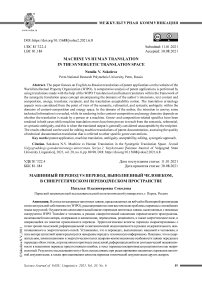Machine vs human translation in the synergetic translation space
Автор: Sokolova Natalia V.
Журнал: Вестник Волгоградского государственного университета. Серия 2: Языкознание @jvolsu-linguistics
Рубрика: Межкультурная коммуникация и сопоставительное изучение языков
Статья в выпуске: 6 т.20, 2021 года.
Бесплатный доступ
The paper focuses on English-to-Russian translations of patent applications on the website of the World Intellectual Property Organization (WIPO). A comparative analysis of patent applications is performed by using translations made with the help of the WIPO Translate tool and human translators within the framework of the synergetic translation space concept encompassing the domains of the author's intensions, text content and composition, energy, translator, recipient, and the translation acceptability notion. The translation erratology aspects were considered from the point of view of the semantic, referential, and syntactic ambiguity within the domains of content-composition and energy space. In the domain of the author, the intention to convey some technical information is revealed, while its rendering in the content-composition and energy domains depends on whether the translation is made by a person or a machine. Genre- and composition-related specifics have been rendered in both cases while machine translation errors have been proven to result from the semantic, referential, or syntactic ambiguity, and this is when the translated output is generally considered unacceptable by the recipient. The results obtained can be used for editing machine translations of patent documentation, assessing the quality of technical documentation translation that is referred to other specific genre conventions.
Patent application, machine translation, ambiguity, acceptability, editing, synergetic approach
Короткий адрес: https://sciup.org/149139452
IDR: 149139452 | DOI: 10.15688/jvolsu2.2021.6.8
Список литературы Machine vs human translation in the synergetic translation space
- Bakhtin M.M., 1986. Problema rechevykh zhanrov [The Problem of Speech Genres]. Estetika slovesnogo tvorchestva [The Aesthetics of Verbal Creativity]. Moscow, Iskusstvo Publ., pp. 250-296.
- Baker M., Saldanha G., eds., 2011. Routledge Encyclopedia of Translation Studies. London and New York, Routledge, Taylor and Francis Group. 22. 674 p.
- Byrne J., 2004. Textual Cognetics and the Role of Iconic Linkage in Software User Guides. Doctoral Dissertation. Dublin, Dublin City University. 357 p.
- Byrne J., 2006. Technical Translation. Usability Strategies for Translating Technical Documentation. Netherlands, Springer, 13. 280 p.
- Fontanet M., 2003. The Technical Translator: The Sherlock Holmes of Translation? .4T4 Chronicle, 2013, July, vol. 42, no. 7, pp. 18-26. URL: https:// www.ata-chronicle.online/wp-content/uploads/ 4207_18_mathilde_fontanet.pdf (accessed 28 November 2020).
- Franco Aixela J., 2004. The Study of Technical and Scientific Translation: An Examination of Its Historical Development. Journal of Specialised Translation, no. 1, pp. 29-49.
- Ketola A., 2015. Translation Diaries of an Illustrated Technical Text. Connexions International Professional Communication Journal, no. 3 (2), pp. 13-40.
- Klushina N.I., 2012. Intentsionalnyi metod v sovremennoi lingvisticheskoi paradigm [Intentional Method in the Modern Linguistic Paradigm]. Mediastilistka [Mediastylistics], iss. 4. URL: http://mediascope.ru/node/1242 (accessed 10 January 2021).
- Kushnina L.V., 2004. Vzaimodeistvieyazykov i kultur v perevodcheskom prostranstve: geshtalt-sinergeticheskiipodkhod: dis.... d-rafilol. nauk [The Interaction of Languages and Cultures in the Translation Space: The Gestalt-Synergetic Approach. Dr. philol. sci. diss.]. Perm. 437 p.
- Kushnina L.V, 2013. Funktsionirovanie tekhnicheskikh tekstov v perevodcheskom prostranstve [The Functioning of Technical Texts in the Translation Space]. Filologicheskie nauki. Voprosy teorii i praktiki [Philological Sciences. Issues of Theory and Practice], no. 11 (29), part 2, pp. 119-121.
- Larson M., 1987. Establishing Project-Specific Criteria for Acceptability of Translations. Rose M.G., ed. Translation Excellence: Assessment, Achievement, Maintenance. American Translators Association Scholarly Monographs. Binghamton, New York, University Center, State University of New York, pp. 69-76.
- Linares J.A.G., 2008. Empirical Machine Translation and Its Evaluation. Doctoral Dissertation. Barcelona. 247 p.
- Lotman Yu.M., 2000. Semiosfera [Semiosphere]. Saint Petersburg, Iskusstvo-SPB Publ. 704 p.
- Lotman Yu.M., 2010. Nepredskazuemye mekhanizmy kultury [Unpredictable Mechanisms of Culture]. Tallinn, TLU Press. 232 p.
- Matveeva T.V., 2006. Tekstovaya kategoriya [Textual Category]. Kozhina M.N., ed. Stilisticheskii entsiklopedicheskii slovar russkogo yazyka [The Stylistic Encyclopedic Dictionary of the Russian Language]. Moscow, Flinta Publ., Nauka Publ., pp. 549-552.
- Miftakhova R.G., 2017. Formalizatsiya estestvennogo yazyka v mashinnom perevode s oporoi na dopolnitel'nyi korpus rodstvennogoyazyka: dis.... kand. filol. nauk [Formalizing the Natural Language Using the Additional Corpus of the Related Language. Cand. philol. sci. diss.]. Ufa. 187 p.
- Nord C., 1997. Translating As a Purposeful Activity. Manchester, St. Jerome Publishing. 154 p.
- Shershukova N.V., 2017. Spetsifika perevoda nauchnykh i tekhnicheskikh tekstov (patentov) [Specifics of Translating Scientific and Technical Texts (Patents)]. Filologicheskie nauki. Voprosy teorii i praktiki [Philological Sciences. Issues of Theory and Practice], no. 3 (69), part 2, pp. 182-184.
- Sokolova N.V., 2019. Mashinnyi perevod patentov: tipichnye oshibki [Machine Patent Translation: Typical Errors]. Mezhkulturnaya kommunikatsiya: lingvisticheskie aspekty: sb. materialov VIIIMezhdunar. nauch.-prakt. konf. (28-29 marta 2019g.) [Intercultural Communication: Linguistic Aspects. Proceedings of the 8th International Scientific and Practical Conference (March 28-29, 2019)]. Novosibirsk, Novosibirskiy gosudarstvennyi tekhnicheskiy universitet, pp. 173-178.
- Toury G., 1995. Descriptive Translation Studies and Beyond. Amsterdam, Philadelphia, John Benjamins. 311 p.
- Trinozhenko M.D., Goncharova Yu.L., 2016. Spetsifika perevoda patentnoi dokumentatsii [Specifics of Translating Patent Documents]. Yunyi issledovatel Dona [Don's Young Researcher], no. 1 (1), pp. 1-6.
- Vlavatskaya M.V., 2011. Teoreticheskie problemy kombinatornoi lingvistiki. Leksikologiya. Leksikografiya [Theoretical Issues of Combinatorial Linguistics. Lexicology. Lexicography]. Novosibirsk, NGTU. 508 p.
- Zhaorong Zong, 2018. Research on the Relations Between Machine Translation and Human Translation. Journal of Physics: Conferences Series, vol. 1087, iss. 06, pp. 1-6. DOI: 10.1088/ 1742-6596/1087/6/062046.


